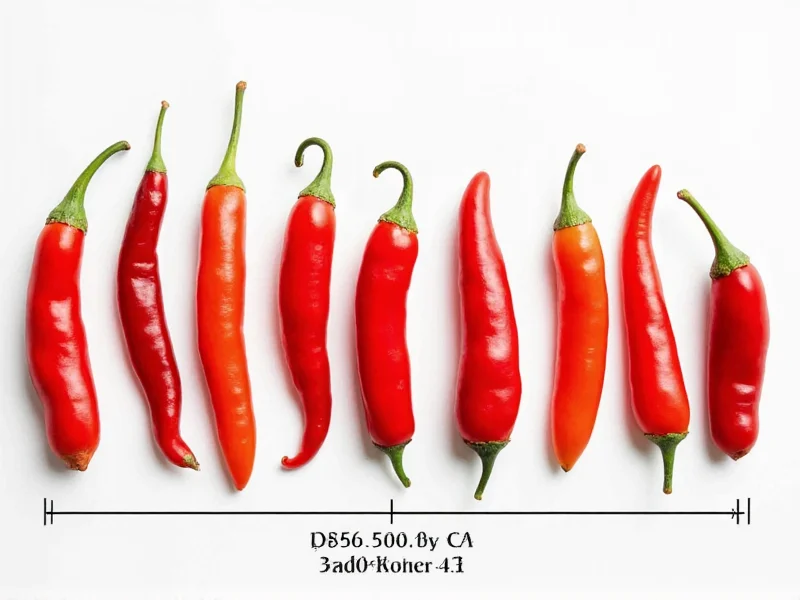Developed in 1912 by American pharmacist Wilbur Scoville, this scale measures the concentration of capsaicinoids—the chemical compounds responsible for the burning sensation we perceive as "heat" in peppers. Understanding how the Scoville scale measures pepper heat is essential for cooks, gardeners, and spice enthusiasts who want to navigate the world of chili peppers safely and effectively.
A Brief History of Pepper Heat Measurement
Before modern technology, Scoville's original method involved diluting pepper extract in sugar water until the heat became undetectable to a panel of tasters. The degree of dilution determined the Scoville rating—a process both subjective and imprecise by today's standards. For example, if a pepper extract needed to be diluted 5,000 times before the heat disappeared, it received a rating of 5,000 SHU.
While the original organoleptic test has been replaced by high-performance liquid chromatography (HPLC), which provides objective chemical analysis, the Scoville scale remains the universal reference for comparing pepper spiciness levels. This transition to scientific measurement has made understanding Scoville heat units for cooking more reliable and consistent.
How the Scoville Scale Works Today
Modern laboratories use HPLC to measure the exact concentration of capsaicinoids in a pepper sample. The results are then converted to Scoville Heat Units using a standardized formula. This scientific approach eliminates human subjectivity while maintaining compatibility with the historical scale that consumers recognize.
It's important to note that Scoville ratings represent a range rather than a fixed number. Environmental factors like soil composition, climate, and cultivation methods can cause significant variation in the heat level of the same pepper variety. When comparing pepper spiciness levels, always consider these natural fluctuations.
Pepper Heat Reference Guide
| Pepper Variety | Scoville Heat Units (SHU) | Common Uses |
|---|---|---|
| Bell Pepper | 0 SHU | Raw consumption, cooking |
| Pepperoncini | 100-500 SHU | Pickling, salads |
| Jalapeño | 2,500-8,000 SHU | Salsas, nachos, poppers |
| Serrano | 10,000-23,000 SHU | Pico de gallo, hot sauces |
| Habanero | 100,000-350,000 SHU | Caribbean cuisine, hot sauces |
| Ghost Pepper (Bhut Jolokia) | 800,000-1,041,427 SHU | Extreme hot sauces, challenges |
| Carolina Reaper | 1,400,000-2,200,000 SHU | World record holder, specialty sauces |
Practical Applications in the Kitchen
Understanding how to use Scoville ratings in recipes transforms your cooking experience. When substituting peppers, remember that a habanero (100,000-350,000 SHU) is approximately 20-40 times hotter than a jalapeño (2,500-8,000 SHU). This knowledge prevents culinary disasters and helps you achieve desired flavor profiles.
Professional chefs often remove seeds and membranes—the parts containing the highest concentration of capsaicin—from hotter peppers to control heat levels while preserving flavor. When working with extremely hot varieties like the Carolina Reaper, always wear gloves and avoid touching your face. The difference between Scoville scale measurements and actual sensory experience can be significant due to individual tolerance variations.
Limitations of the Scoville Scale
While the Scoville scale provides valuable comparative data, it has several limitations. The scale doesn't account for the quality of heat—some peppers produce immediate burning sensations while others create delayed, longer-lasting effects. Additionally, individual physiology affects heat perception; what seems moderately hot to one person might be unbearable to another.
Recent research suggests that the Scoville scale oversimplifies the complex interaction between capsaicinoids and human pain receptors. Newer measurement systems like the ASTA pungency units provide more detailed chemical analysis but haven't gained widespread consumer recognition. For most practical purposes, however, understanding Scoville heat units remains the most accessible way to navigate pepper selection.
Safety Considerations with High-Heat Peppers
Working with extremely hot peppers requires precautions. Always handle super-hot varieties like the Trinidad Moruga Scorpion or Carolina Reaper with gloves, and work in well-ventilated areas. The capsaicin in these peppers can cause severe skin irritation and respiratory discomfort.
If you accidentally touch your eyes after handling hot peppers, rinse immediately with milk or a specialized capsaicin removal solution—water alone won't help. When consuming extremely spicy foods, dairy products like yogurt or milk provide relief by binding to capsaicin molecules, while starchy foods like bread can help absorb excess oil.
Emerging Research and Future Developments
Scientists continue to explore the genetic factors that determine pepper heat levels, potentially leading to more precise breeding of varieties with consistent heat profiles. Research into capsaicin's medical applications—from pain management to weight loss—further underscores the importance of accurate heat measurement.
As consumer interest in global cuisines grows, understanding pepper spiciness levels becomes increasingly valuable. Whether you're a home cook experimenting with new recipes or a professional chef developing signature dishes, the Scoville scale provides an essential framework for navigating the diverse world of chili peppers.











 浙公网安备
33010002000092号
浙公网安备
33010002000092号 浙B2-20120091-4
浙B2-20120091-4